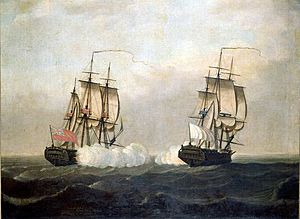Battle of Negapatam (1758) facts for kids
Quick facts for kids Battle of Negapatam |
|||||||
|---|---|---|---|---|---|---|---|
| Part of the Seven Years' War | |||||||
 British East Indiaman Pitt (left) engaging French East Indiaman St Louis |
|||||||
|
|||||||
| Belligerents | |||||||
| Commanders and leaders | |||||||
| Strength | |||||||
| 7 ships of the line | 8 ships of the line 1 frigate |
||||||
| Casualties and losses | |||||||
| 31 killed 166 wounded |
250 killed 600 wounded |
||||||
The Battle of Negapatam was a big naval fight that happened on August 3, 1758. It was part of the Seven Years' War, a huge global conflict. This battle took place off the coast of India, near a place called Negapatam.
In this battle, the British navy, led by Vice-Admiral George Pocock, faced off against the French navy, commanded by Comte d'Aché. It was the second time these two admirals fought each other during the war.

Contents
What Happened at Negapatam?
The battle was short but very intense. Both sides had many ships and fired their cannons at each other. The ships took a lot of damage during the fight.
Key Moments in the Battle
During the battle, the French flagship, a ship called Zodiaque, caught fire. This was a very serious problem for the French.
Also, the French commander, Comte d'Aché, was badly hurt during the fighting. He had to spend the rest of that year recovering from his injuries in Mauritius.
Who Won the Battle?
Even though both sides fought hard and suffered damage, the battle ended without a clear winner. This is called an indecisive battle. Neither the British nor the French could claim victory.
Both fleets had many sailors killed or wounded. The British had 31 killed and 166 wounded. The French had even more, with 250 killed and 600 wounded.
Why Was This Battle Important?
This battle was part of the larger Seven Years' War. This war was fought all over the world, including in India. Britain and France were rivals, fighting for control and power.
Naval battles like Negapatam were crucial because they decided who controlled the seas. Controlling the seas meant a country could move troops and supplies. It also helped them protect their trade routes.
Even though this battle didn't have a clear winner, it showed how fiercely both sides fought. It was one of several important naval clashes in the Indian Ocean during the war.
Images for kids


